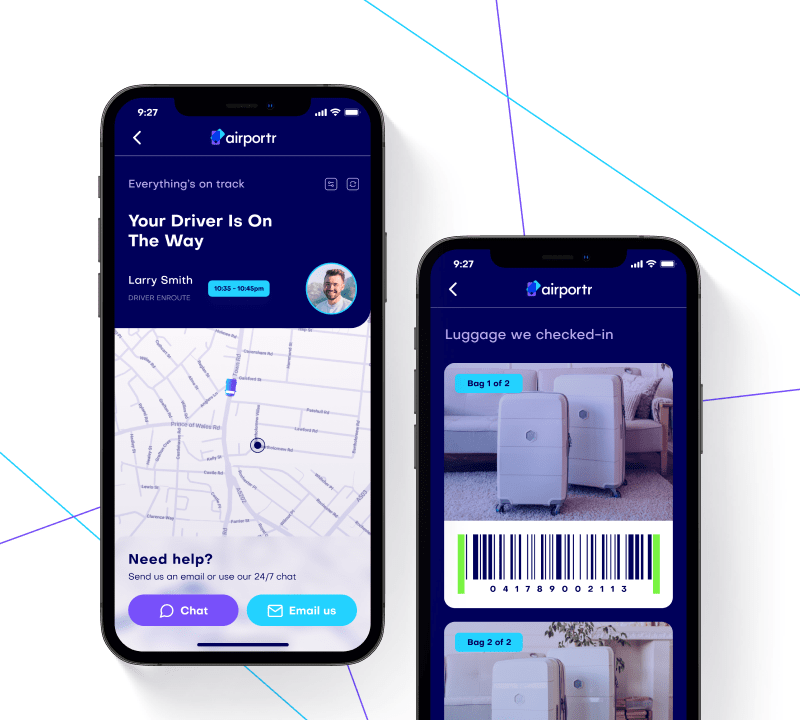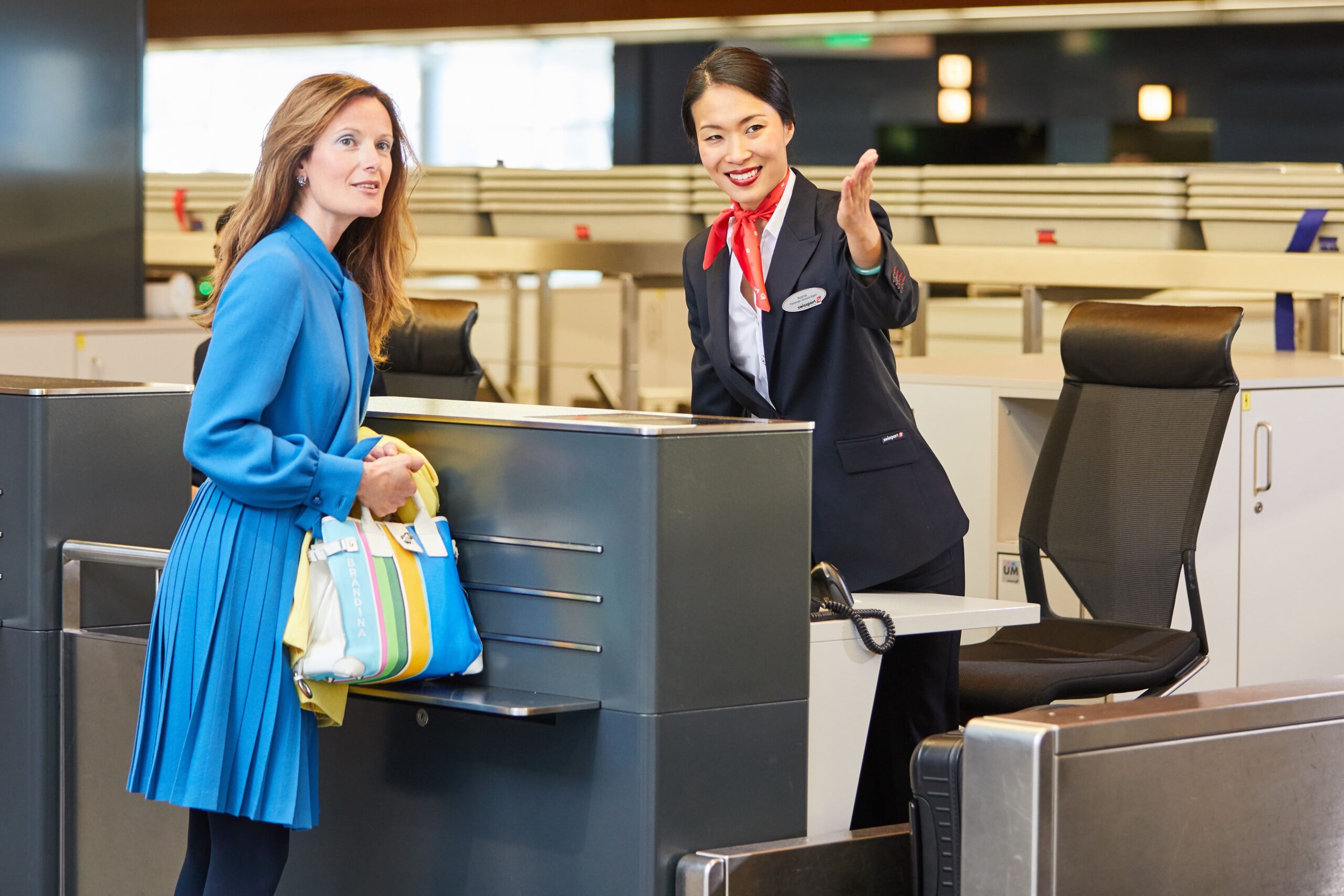Prior to the Covid-19 pandemic causing havoc for the aviation industry, the issue of passenger baggage was one which many airlines faced, with long lines of passengers waiting to collect bags to check in queues. As the industry reopens congestion at airports globally is increasing due to escalated passenger safety and documentation checks. Paired with the issue of lengthy baggage check in, this could be a key setback for the industry’s recovery.
The partnership of AirPortr and Swissport enables passengers to pre-book at-home baggage collection prior to their departure to the airport, which will see a courier collect their bags and digitally verify ID and travel documents at the passenger’s doorstep.
This process allows passengers to travel baggage free to the airport and proceed directly to security, as well as enjoying the streamlining of the last leg of the passenger’s journey – allowing their bags to be cleared through Customs and delivered to their destination within hours of landing.
Alongside providing a contactless, modernised baggage solution for passengers, the partnership also provides a sustainable, environmentally beneficial element.
According to data provided by AirPortr, 66% of customers using this service have switched from using their cars to get to the airport, to using public transport, which will assist the aviation industry on its journey of meeting its sustainability targets.
Randel Darby, CEO at AirPortr, Andrew Price, independent consultant and former IATA head of global baggage, and Sadri Maliqi, project manager at Swissport to discuss the new partnership and the benefits that it brings.

US Tariffs are shifting - will you react or anticipate?
Don’t let policy changes catch you off guard. Stay proactive with real-time data and expert analysis.
By GlobalData
Frankie Youd (FY): When did the partnership between Swissport and AirPortr come about?
Randel Darby (RD): The AirPortr and Swissport teams first met at Plug and Play, Silicon Valley at the beginning of 2020. Despite the world of aviation falling apart shortly after this, we were able to continue conversations and work on ways to collaborate. We began the implementation phase for the project in early 2021.
Sadri Maliqi (SM): At the time, a team in Geneva had already been working on a Swissport-internal off-airport check-in solution. During 2020, the efforts of both parties were then combined to create a strategic partnership between Airportr and Swissport.
When is this technology going to be available for passengers, will this be at all Swissport locations?
RD: The first deployment will launch imminently, and by this we mean within the next month. Once this first market is announced, we will work together as a group to prioritise markets based on a number of criteria: Size, readiness, type of customers flying with an airline (are they tech savvy or tech ready), whether the airline themselves are innovative or digitally progressive enough to support the product.
The footprint of Swissport’s 274 airports worldwide gives a great platform to create a global connected network for airline clients. There is an immense amount of scale with this and the possibility to transform baggage from a customer and cost pain point into new revenue streams.
How do passengers become involved with this technology, what is the process for them?
RD: Our model means that we work with organisations like Swissport on the supply side, giving us the infrastructure and services to provide the product globally. We then work with the airlines to integrate and offer the service to the customer. The customers will book through the airline, powered by the AirPortr platform which is integrated. AirPortr also provides customers with easy-to-use, intuitive web-based apps to track bags, couriers, amend bookings etc.

What are the key benefits for not only passengers using this technology but also the airports?
RD: The benefits for the passengers are plenty. It will allow them to save time, avoid queues, give them an enhanced customer experience, and open up the possibility of intermodal travel (e.g. to use rail over private vehicle). For airports, it gives them the opportunity to decongest terminals, alleviate pressure on the baggage processing by pushing it upstream, earlier and off-site, as well as allow optimisation of times (e.g. when the baggage system utilisation is low).
For airlines, the benefits include ancillary revenue, improved customer experience, improved revenue, and allows them to support their automation initiatives to enable more interactions to be handled with fewer agents. Ultimately, this product moves more processes off-site (similar to online check-in and biometrics).
SM: For Swissport, the benefits include ground handling efficiencies, it gives us a new service in our portfolio and brings about innovation.
Was this technology in development prior to the impacts of the pandemic or did the pandemic act as a catalyst for this type of technology?
RD: We first launched our digitised off-airport service in late 2016 with British Airways. Pre-pandemic, AirPortr was actively scaling the technology with airlines and airports, working with third-party handlers to leverage its tools and technology to transform the sector. With the global shutdown of air travel and the impacts this had on revenues across the industry, our business model accelerated from consumer focussed to a global B2B platform for smarter baggage management for the industry.
Last year we doubled down on investment to push our platform and applications toward more of an enterprise offering for large scale B2B operating partners, like Swissport.
The pandemic certainly acted as a catalyst for our growth – by transforming the door-to-door customer experience for air passenger, and helping operators to reduce their costs and increase the throughput of their infrastructure, AirPortr is now at the forefront of a digital shift within the aviation industry.
66% of AirPortr users are switching from car usage to public transport, do you see this number increasing and feel that the industry’s goal of halving emissions by 2050 will be achieved?
RD: As confidence in new products like Airportr grows and are invested in by the air transport sector, giving customers the option to travel to the airport baggage free, we will see a continued change in passenger behaviour and a rise in the use of intermodal transport. Two thirds of people are already saying they switch to public transport when no longer blocked by baggage.
I believe as well that with deeper integrations between technology providers like AirPortr, mobility and ground transportation platforms, allowing ‘one purchase’ of bag free intermodal journeys, this will drive an even greater shift over time.
There has already been immense progress made to meet emissions targets for the industry, such as testing of sustainable aviation fuels, governments limiting domestic flying in favour of rail travel, airports increasing charges for taxis or passenger vehicle set down etc.. It will take a lot of collaboration between the industry – including technology providers, airlines, ground handlers, transport providers and governments – but as the last year has shown, a huge amount can be achieved in a short space of time, if the forces align and there is sufficient motivation across industry to make it happen.
Do you feel that technology such as this will be the future for the aviation industry?
RD: It is evident that there was a place for this type of technology pre-pandemic and that the industry was trying to harness this, for example to alleviate capacity challenges in airports. Post-pandemic and the space for this is even bigger – it has accelerated the uptake of digital technologies and fact-tracked innovation across the industry.
We have seen huge shifts across other industries that we can draw parallels with when looking at the future of the aviation industry. Take Amazon and the change in consumer behaviours towards ecommerce for example. The way people shop now is vastly different to how they were – the high street is no longer as it was. With at home deliveries, rapid convenient service levels and online ordering now embedded with consumer segments that perhaps two years ago wouldn’t have considered it as an everyday option for them. The airport of the future, I believe, will face similar positive disruption, and if it doesn’t change to adapt, will become the high street.
There is a long-term shift happening across the industry, and we know airports are master planning for 2030 to 2035+ for ‘passenger only’ terminals. This tells you that this kind of technology is becoming embedded in future design thinking.
SM: Digitization and decentralization of airport processes is the future of the aviation industry. Digital passenger and baggage processes will minimize the number of touch points at the airport and thus the likelihood of bottlenecks and lost time. Off-airport baggage handling is gradually transforming the customer journey and airport baggage handling processes.
Andrew Price (AP):
Fundamentally this technology brings a win to every stakeholder in an air travel journey, so it ought to be a part of the future of aviation.
It is not unusual for baggage systems to cost many millions to build, and then they are used at peak for perhaps three hours per day. You can greatly reduce these costs by controlling the flow of bags into the system and de-peaking the baggage flow, off-airport services such as those offered by AirPortr are really the only way to do this.
For the passenger there is an even greater benefit. Being able to check your bag in early, without the need to carry it to the airport is a huge win. Families travelling can relax more and enjoy the trip to the airport, rather than being stressed about the queues they might face when they get there. Coming home you can check out of your hotel and the bag can already be on its journey, leaving you hands free to enjoy that last day sightseeing or at the beach. Airlines get a benefit of having more information about the number of bags on the flight earlier, allowing them to take more cargo, as well as having fewer no-show passengers.
One of the great phrases I have heard post Covid-19 is that we need to rebuild aviation, but better. This is a great enabler for a better journey.





